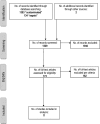A systematic review of outcomes following repair of complex ventral incisional hernias with biologic mesh
- PMID: 24229031
- PMCID: PMC3829071
- DOI: 10.9738/INTSURG-D-12-00002.1
A systematic review of outcomes following repair of complex ventral incisional hernias with biologic mesh
Abstract
Repair of contaminated/infected ventral incisional hernias is marked by high rates of recurrence, complications, and/or explantation of synthetic mesh. Biologic mesh products are recommended for repair to permit reconstruction and reduce complications. A systematic review of PubMed, EMBASE, and Cochrane databases identified English-language articles reporting postoperative outcomes (e.g., hernia recurrence, infection, mesh explantation) in patients undergoing contaminated/infected ventral incisional herniorrhaphy. Eleven studies met inclusion criteria and contained quantitative outcome data. All were retrospective chart reviews of biologic mesh use (mostly human acellular dermal matrix). Hernia recurrence and wound infection rates were highly variable and inconsistently reported across studies. Mesh explantation was rarely reported. Outcome variability is likely owing to heterogenous patient populations, surgical technique variations, and follow-up duration. Biologic mesh use in contaminated/infected herniorrhaphy was marked by low reported rates of secondary surgeries for infected mesh removal. Data from large, well-controlled, prospective trials with biologic mesh products are needed.
References
-
- Israelsson LA, Jonsson T. Incisional hernia after midline laparotomy: a prospective study. Eur J Surg. 1996;162(2):125–129. - PubMed
-
- Mudge M, Hughes LE. Incisional hernia: a 10 year prospective study of incidence and attitudes. Br J Surg. 1985;72(1):70–71. - PubMed
-
- Voeller GR. Innovations in ventral hernia repair. Surg Technol Int. 2007;16:117–122. - PubMed
-
- Breuing K, Butler CE, Ferzoco S, Franz M, Hultman CS, Kilbridge JF, et al. Incisional ventral hernias: review of the literature and recommendations regarding the grading and technique of repair. Surgery. 2010;148(3):544–558. - PubMed
-
- Anthony T, Bergen PC, Kim LT, Henderson M, Fahey T, Rege RV, et al. Factors affecting recurrence following incisional herniorrhaphy. World J Surg. 2000;24(1):95–100. - PubMed
Publication types
MeSH terms
LinkOut - more resources
Full Text Sources
Other Literature Sources
Medical
Miscellaneous


